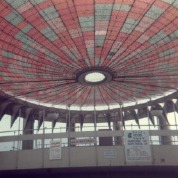The World’s Fair Tent of Tomorrow
Designated a National Treasure by the National Trust for Historic Preservation
 Over 2500 viewers swarmed into Flushing Meadows, Corona Park, Queens, on Earth Day, April 22, for a one-time visit inside the “Tent of Tomorrow,” a 350 x 250-foot pavilion designed by Modernist architect Philip Johnson for the 1964 World’s Fair, and this monument was designated a National Treasure in a ceremony on the same day. Advocates and conservationists for preserving the structure are still weighing the costs of restoration – 42 to 52 million — versus the cost of demolition – 14 million. The new historic label from The National Trust for Historic Preservation — bestowed on only 40 buildings in the USA – boosts the arguments of preservationists. Image: [Filename – I.e., New York State Pavilion], 1964 New York World’s Fair. Queens Museum Collection. Courtesy Queens Museum.
Over 2500 viewers swarmed into Flushing Meadows, Corona Park, Queens, on Earth Day, April 22, for a one-time visit inside the “Tent of Tomorrow,” a 350 x 250-foot pavilion designed by Modernist architect Philip Johnson for the 1964 World’s Fair, and this monument was designated a National Treasure in a ceremony on the same day. Advocates and conservationists for preserving the structure are still weighing the costs of restoration – 42 to 52 million — versus the cost of demolition – 14 million. The new historic label from The National Trust for Historic Preservation — bestowed on only 40 buildings in the USA – boosts the arguments of preservationists. Image: [Filename – I.e., New York State Pavilion], 1964 New York World’s Fair. Queens Museum Collection. Courtesy Queens Museum.
 The Johnson Pavilion, which has a futurist look, is a circular structure bounded by sixteen 100-foot-high concrete columns, which were made using the slip-cast method of moving the mold after the cement inside dries enough to sustain its shape. The original outside walls around the 100-foot columns were the site of the 20 x 20 – foot panels by ten chosen artists, including Warhol. All that remains of the original wall is a low circular base; this is painted in bold red and white panels to commemorate the original panels made of canvas. Image: [Filename – I.e., New York State Pavilion], 1964 New York World’s Fair. Queens Museum Collection. Courtesy Queens Museum.
The Johnson Pavilion, which has a futurist look, is a circular structure bounded by sixteen 100-foot-high concrete columns, which were made using the slip-cast method of moving the mold after the cement inside dries enough to sustain its shape. The original outside walls around the 100-foot columns were the site of the 20 x 20 – foot panels by ten chosen artists, including Warhol. All that remains of the original wall is a low circular base; this is painted in bold red and white panels to commemorate the original panels made of canvas. Image: [Filename – I.e., New York State Pavilion], 1964 New York World’s Fair. Queens Museum Collection. Courtesy Queens Museum.
 The high columns once held a 50,000-square-foot polychrome tile roof, which no longer exists. The roof was suspended on a cable system designed like a giant bicycle tire – with a compression ring on the outside and a tension ring on the inside. The cable system is intact but rusting; it seems to tilt to one side, but this is an optical illusion. Image: [Filename – I.e., New York State Pavilion], 1964 New York World’s Fair. Queens Museum Collection. Courtesy Queens Museum.
The high columns once held a 50,000-square-foot polychrome tile roof, which no longer exists. The roof was suspended on a cable system designed like a giant bicycle tire – with a compression ring on the outside and a tension ring on the inside. The cable system is intact but rusting; it seems to tilt to one side, but this is an optical illusion. Image: [Filename – I.e., New York State Pavilion], 1964 New York World’s Fair. Queens Museum Collection. Courtesy Queens Museum.
 This structure once had glass elevators named the “Sky Streak” that scaled the outside of the building and two adjoining circular towers, stopping at 60, 150, and 226 feet to let visitors off at two cafeterias, a gift shop, and an observation deck. The side towers still exist and add to the structure’s futurist look. The main lower floor used to have a terrazzo replica of the Texaco New York State highway map, marked with towns and Texaco gas stations. Image: [Filename – I.e., New York State Pavilion], 1964 New York World’s Fair. Queens Museum Collection. Courtesy Queens Museum.
This structure once had glass elevators named the “Sky Streak” that scaled the outside of the building and two adjoining circular towers, stopping at 60, 150, and 226 feet to let visitors off at two cafeterias, a gift shop, and an observation deck. The side towers still exist and add to the structure’s futurist look. The main lower floor used to have a terrazzo replica of the Texaco New York State highway map, marked with towns and Texaco gas stations. Image: [Filename – I.e., New York State Pavilion], 1964 New York World’s Fair. Queens Museum Collection. Courtesy Queens Museum.
— Special to AAQ East End by Jan Garden Castro
The National Trust for Historic Preservation, a privately funded nonprofit organization, works to save America’s historic places. Visit: www.preservationnation.org
———————————————————————–
— Jan Castro (www.jancastro.com) is an art historian and author based in Brooklyn. She is is Contributing Editor at Sculpture Magazine; her “In the Studio” blog is posted at Sculpture.org.
____________________________________________________________________
